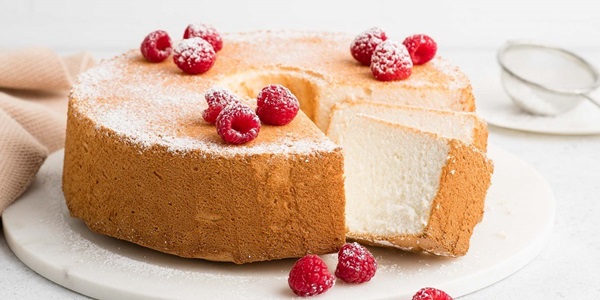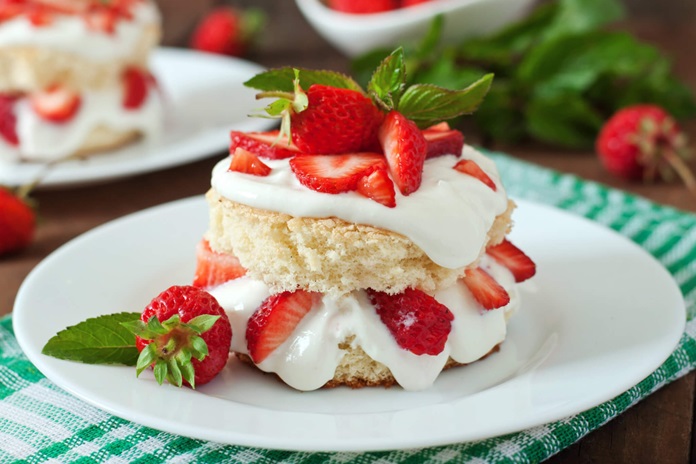National Angel Food Cake Day is on October 10, and we recommend using a mixer to make this tasty treat unless you want an arm workout. This light and fluffy dessert gets its name from its airy texture and is loved by many people worldwide.
History of National Angel Food Cake Day
Angel food cake is a low-carb dessert made primarily from well-beaten egg whites mixed with flour and sugar. It is known for its light, chewy, and airy texture. Similarly, this cake has been a beloved American favorite since its creation.
The exact origins of angel food cake are still debated, though it’s widely believed to have originated in the United States in the mid-1800s.
Some historians credit African American slaves with its invention, as making the cake required the strenuous task of whipping air into the egg whites. Others argue that it may have originated in southeastern Pennsylvania due to the region’s abundant production of cake molds at the time.
Regardless of its origin, angel food cake holds different cultural meanings among various ethnic groups and indigenous communities.
For African Americans, it is often served at funeral receptions, symbolizing the departed’s transition into the realm of angels.

Among the Pennsylvania Dutch, it is traditionally used as a wedding cake, representing the blessing of the couple’s union by the angels.
Despite its varying cultural significance, everyone can agree that angel food cake is a delightful treat, no matter the occasion. It’s especially tasty when topped with a glaze or whipped cream for added sweetness.
The origins of the celebration of this day are unknown, but its popularity has spread so widely that people across the United States and in other parts of the world celebrate it each year.
Timeline of National Angel Food Cake Day
| 1800s (Angel Food Cake Popularity) | This fluffy lightweight delicious delight has become popular in the United States. |
| 1839 (“The Kentucky Housewife”) | The first recipe for a sponge cake is written in Lettice Bryan’s cookbook. |
| 1878 (“The Home Messenger Book of Tested Recipes”) | Isabella Stewart’s cookbook contains the first recipe for angel food cake. |
| 1884 (“Boston Cooking School Cook Book”) | A recipe for something called ‘angel cake,’ something very similar to the original angel food cake recipes, appears in a cookbook by Mary Lincoln. |
5 Interesting Facts About Angel Food Cakes
- Unique Ingredients and Preparation: Angel food cake is distinct because it doesn’t use any butter or fat, unlike most cakes. The main ingredients are egg whites, sugar, and flour. The cake’s light and airy texture comes from whipping the egg whites to stiff peaks, which are then gently folded into the batter. This gives the cake its signature fluffy and spongy consistency.
- Named for Its Heavenly Texture: Angel food cake got its name because of its light, fluffy, and delicate texture, which many describe as being as light as a cloud—so light that it was deemed fit for angels! The cake’s pure white color and airy nature also contribute to its heavenly reputation.
- Baked in a Tube Pan: Traditionally, angel food cakes are baked in an ungreased tube pan, which helps the cake rise higher. The pan’s center tube allows hot air to circulate through the middle of the cake, ensuring even cooking. The ungreased sides of the pan help the cake cling and climb upwards during baking.
- Upside-Down Cooling Method: After baking, angel food cakes are often inverted and left to cool upside-down. This technique prevents the delicate structure from collapsing and helps maintain the cake’s height and airy texture. Special tube pans even come with feet on the edges to make this cooling process easier.
- Popular During Diet-Conscious Eras: Angel food cake gained popularity during times when people were more diet-conscious because it’s lower in calories and fat compared to other cakes. It’s often enjoyed plain, with a light glaze, or topped with fresh fruit, making it a popular dessert choice for those seeking a lighter option.
Conclusion
National Angel Food Cake Day on October 10th celebrates a light, airy dessert with a rich history and unique cultural significance. From its debated origins in the United States to its distinct preparation methods, angel food cake has carved a special place in culinary traditions worldwide. Whether enjoyed plain, topped with fresh fruit, or served on meaningful occasions, this cake remains a delightful and versatile treat. So, on this day, grab a slice, appreciate the delicate balance of flavor and texture, and savor the heavenly bite of this beloved dessert.
Frequently Ask Question
Why is it called angel food cake?
Angel food cake is named for its light, fluffy, and delicate texture, which many describe as being as light as a cloud. The cake’s pure white color and airy nature contribute to its heavenly reputation.
What are the main ingredients in angel food cake?
The primary ingredients in angel food cake are egg whites, sugar, and flour. Unlike most cakes, it does not use butter or fat. The cake’s light texture comes from whipping the egg whites to stiff peaks and gently folding them into the batter.
How is angel food cake baked?
Angel food cake is traditionally baked in an ungreased tube pan. This pan helps the cake rise higher by allowing hot air to circulate through the middle and ensuring even cooking. The ungreased sides of the pan help the cake cling and climb upwards during baking.
Why is angel food cake cooled upside-down?
After baking, angel food cakes are often inverted and left to cool upside-down. This technique prevents the delicate structure from collapsing and helps maintain the cake’s height and airy texture. Some tube pans come with feet to facilitate this cooling process.
What is the history of angel food cake?
Angel food cake has been a beloved American favorite since the mid-1800s. While its exact origins are debated, it is believed to have either been invented by African American slaves or originated in southeastern Pennsylvania. The cake holds different cultural meanings among various ethnic groups.
You may also like to read, Banana Pudding Lovers Month – November 2024
